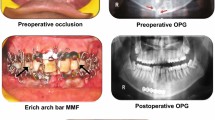Abstract
Various methods have been used to treat zygomatic arch fractures, but no optimal modality exists for reducing these fractures and supporting the depressed bone fragments without causing esthetic problems and discomfort for life. We developed a novel aqua splint and suture technique for stabilizing isolated zygomatic arch fractures. The objective of this study is to evaluate the effect of novel aqua splint and suture technique in isolated zygomatic arch fractures. Patients with isolated zygomatic arch fractures were treated by a single surgeon in a single center from January 2000 through December 2012. Classic Gillies approach without external fixation was performed from January 2000 to December 2003, while the novel technique has been performed since 2004. 67 consecutive patients were included (Classic method, n = 32 and Novel method, n = 35). An informed consent was obtained from all patients. The novel aqua splint and suture technique was performed by the following fashion: first, we evaluated intraoperatively the bony alignment by ultrasonography and then, reduced the depressed fracture surgically using the Gillies approach. Thereafter, to stabilize the fracture and obtain the smooth facial figure, we made an aqua splint that fit the facial contour and placed monofilament nonabsorbable sutures around the fractured zygomatic arch. The novel aqua splint and suture technique showed significantly correlated with better cosmetic and functional results. In conclusion, the aqua splint suture technique is very simple, quick, safe, and effective for stabilizing repositioned zygomatic arch fractures. The aqua splint suture technique can be a good alternative procedure in isolated zygomatic arch fractures.



Similar content being viewed by others
References
El-Hadidy AM (2005) The use of a Foley catheter in isolated zygomatic arch fractures. Plast Reconstr Surg 116(3):853–856
Yamamoto K, Murakami K, Sugiura T, Fujimoto M, Inoue M, Kawakami M, Ohgi K, Kirita T (2007) Clinical analysis of isolated zygomatic arch fractures. J Oral Maxillofac Surg 65(3):457–461. doi:10.1016/j.joms.2006.06.276
Gillies R, Geary N (1992) Unusual pronation dorsiflexion fractures of the ankle. Injury 23(5):353–354
Poswillo D (1976) Reduction of the fractured malar by a traction hook. Br J Oral Surg 14(1):76–79
Krishnan B, El Sheikh MH (2008) Dental forceps reduction of depressed zygomatic arch fractures. J Craniofac Surg 19(3):782–784. doi:10.1097/SCS.0b013e31816ae332
Guven O (1988) Self-curing acrylic in the treatment of unstable zygomatic arch fracture. J Nihon Univ Sch Dent 30(2):141–144
Honig JF, Merten HA (2004) Classification system and treatment of zygomatic arch fractures in the clinical setting. J Craniofac Surg 15(6):986–989
Ogden GR (1991) The Gillies method for fractured zygomas: an analysis of 105 cases. J Oral Maxillofac Surg 49(1):23–25 discussion 26
Gulicher D, Krimmel M, Reinert S (2006) The role of intraoperative ultrasonography in zygomatic complex fracture repair. Int J Oral Maxillofac Surg 35(3):224–230. doi:10.1016/j.ijom.2005.10.005
Soejima K, Sakurai H, Nozaki M, Kitazawa Y, Takeuchi M, Yamaki T, Kono T (2009) Semi-closed reduction of tripod fractures of zygoma under intraoperative assessment using ultrasonography. J Plast Reconstr Aesthet Surg 62(4):499–505
Camilleri AC, Gilhooly M, Cooke ME (2005) Stabilisation of the unstable fractured zygomatic arch with a Kirschner wire. Br J Oral Maxillofac Surg 43(2):183–184. doi:10.1016/j.bjoms.2004.08.004
Uglesic V, Virag M (1994) A method of zygomatic arch stabilization. Br J Oral Maxillofac Surg 32(6):396–397
Rodriguez-Vegas JM, Casado Perez C (2004) Inexpensive custom-made external splint for isolated closed zygomatic arch fractures. Plast Reconstr Surg 113(5):1517–1518
Zaworski RE (1980) A simple support for unstable fractures of the zygomatic arch. Plast Reconstr Surg 65(5):673
Paludetti G, Corina L, Parrilla C, Scarano E, Almadori G (2002) Surgical features on intraoral approach for the management of isolated zygomatic arch fractures. Acta Otorhinolaryngol Ital 22(5):280–283
Acknowledgments
This work was supported by a grant from Bio-industry Technology Development (111100-03-1-SB010), Ministry for Food, Agriculture, Forestry and Fisheries, and the BioGreen 21 Program (No. PJ009051062012), Rural Development Administration, Republic of Korea.
Conflict of interest
All authors have no conflicts of interest, commercial associations, or intent of financial gain regarding this research.
Author information
Authors and Affiliations
Corresponding author
Rights and permissions
About this article
Cite this article
Kim, DK., Kim, S.K., Lee, J.H. et al. Aqua splint suture technique in isolated zygomatic arch fractures. Eur Arch Otorhinolaryngol 271, 707–711 (2014). https://doi.org/10.1007/s00405-013-2602-1
Received:
Accepted:
Published:
Issue Date:
DOI: https://doi.org/10.1007/s00405-013-2602-1




